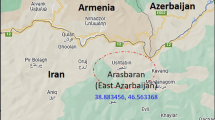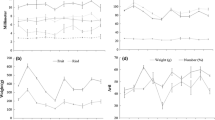Abstract
Pomegranate is considered a functional food but several local accessions and cultivars are widespread in different countries. The characterization of local germoplasm allows to identify genotypes that possess the highest nutraceutical value compared to standard cultivars (cvs.) and that are well-adapted to local climatic conditions and could be used in the breeding programs. The aim of this study was the characterization of pomological and physico-chemical traits as well as antioxidant system in local pomegranate accessions (‘Mondrone Dolce’, ‘San Pietro’, ‘Granato’ and ‘Roce’), comparing to an Italian (‘Dente di Cavallo’) and international cvs. (‘Wonderful’). A high variability of the pomological traits resulted among the cultivars. ‘Wonderful’ showed the highest value of anthocyanins (554.99 ± 0.05 mg C3gE L−1), total phenols (1494.00 ± 116.20 mg GAE L−1) and antioxidant activity (EC50 values 21.21 ± 0.05 µL mL−1), whereas ‘Granato’ had the highest values among local accessions. Furthermore, the antioxidant enzymes activities varied with genotypes. Principal component analysis revealed great differences in all investigated parameters among pomegranate genotypes. ‘Mondrone Dolce’, ‘San Pietro’ and ‘Dente di Cavallo’ showed similar pomological and nutraceutical traits compared to ‘Granato’ and ‘Roce’. Conversely, ‘Wonderful’, due to its peculiar traits, revealed significant differences with respect to other genotypes.



Similar content being viewed by others
References
Stover ED, Mercure EW (2007) The pomegranate: a new look at the fruit of paradise. HortScience 42:1088–1092
Tuppo L, Alessandri C, Pasquariello MS, Petriccione M, Giangrieco I, Tamburrini M, Mari A, Ciardiello MA (2017) Pomegranate cultivars: identification of the new IgE-binding protein pommaclein and analysis of antioxidant variability. J Agric Food Chem 65:2702–2710
Basu A, Penugonda K (2009) Pomegranate juice: a heart healthy fruit juice. Nutr Rev 67:49–56
Adiletta G, Liguori L, Albanese D, Russo P, Di Matteo M, Crescitelli A (2017) Soft-Seeded pomegranate (Punica granatum L.) varieties: preliminary characterization and quality changes of minimally processed arils during storage. Food Bioprocess Tech 10:1631–1641
Calani L, Beghè D, Mena P, Del Rio D, Bruni R, Fabbri A, Dall’Asta C, Galaverna G (2013) Ultra-HPLC—MSn (poly)phenolic profiling and chemometric analysis of juices from ancient Punica granatum L. cultivars: a non targeted approach. J Agric Food Chem 61:5600–5609
Ferrara G, Cavoski I, Pacifico A, Tedone L, Mondelli D (2011) Morpho-pomological and chemical characterization of pomegranate (Punica granatum L.) genotypes in Apulia region, Southeastern Italy. Sci Hortic 130:599–606
Ferrara G, Giancaspro A, Mazzeo A, Giove SL, Matarrese AMS, Pacucci C, Punzi R, Trani A, Gambacorta G, Blanco A, Gadaleta A (2014) Characterization of pomegranate (Punica granatum L.) genotypes collected in Puglia region, Southeastern Italy. Sci Hortic 178:70–78
Todaro A, Cavallaro R, La Malfa S, Continella A, Gentile A, Fischer UA, Carle R, Spagna G (2016) Anthocyanin profile and antioxidant activity of freshly squeezed pomegranate (Punica granatum L.) juices of sicilian and spanish provenances. Ital J Food Sci 28:464–477
Sarkhosh A, Zamani Z, Fatahi R, Ranjbar H (2009) Evaluation of genetic diversity among Iranian soft-seed pomegranate accessions by fruit characteristics and RAPD markers. Sci Hortic 12:313–319
UPOV (2012) Guidelines for the conduct of tests for distinctness, uniformity and stability. Pomegranate (Punica granatum L.). TG/PGRAN/3:1-34
AOAC (1990) Official methods of analysis, 16th edn. Association of Official Analytical Chemists, Washington, DC
Singleton VL, Rossi JA (1965) Colorimetry of total phenolics with phosphomolybdic-phosphotungstic acid reagents. Am J Enol Viticult 16:144–158
Liguori L, Attanasio G, Albanese D, Di Matteo M (2010) Aglianico wine dealcoholization tests. Comput Aided Chem Eng 28(C):325–330
Brasiello A, Crescitelli S, Adiletta G, Di Matteo M, Albanese D (2011) Mathematical model with shrinkage of an eggplant drying process. Chem Eng Trans 24:451–456
Adiletta G, Russo P, Crescitelli A, Di Matteo M (2016) Combined pretreatment for enhancing quality of dried and rehydrated eggplant. Food Bioprocess Tech 9:1912–1923
Chandra A, Rana J, Li YQ (2001) Separation, identification, quantification, and method validation of anthocyanins in botanical supplement raw materials by HPLC and HPLC-MS. J Agric Food Chem 49:3515–3521
Fawole OA, Opara UL, Theron KI (2012) Chemical and phytochemical properties and antioxidant activities of three pomegranate cultivars grown in South Africa. Food Bioprocess Tech 5:2934–2940
Adiletta G, Russo P, Senadeera W, Di Matteo M (2016) Drying characteristics and quality of grape under physical pretreatment. J Food Eng 172:9–18
Liguori L, De Francesco G, Russo P, Perretti G, Albanese D, Di Matteo M (2016) Quality attributes of low-alcohol top-fermented beers produced by membrane contactor. Food Bioprocess Tech 9:191–200
Liguori L, De Francesco G, Russo P, Albanese D, Perretti G, Di Matteo M (2015) Quality improvement of low craft beer produced by evaporative pertraction. Chem Eng Trans 43:13–18
Bradford MM (1976) A dye binding assay for protein. Anal Biochem 72:248–254
Pasquariello MS, Di Patre D, Mastrobuoni F, Zampella L, Scortichini M, Petriccione M (2015) Influence of postharvest chitosan treatment on enzymatic browning and antioxidant enzyme activity in sweet cherry fruit. Postharvest Biol Technol 109:45–56
Martinez JJ, Melgarejo P, Hernandez F, Salazar DM, Martinez R (2006) Seed characterization of five new pomegranate (Punica granatum L.) varieties. Sci Hortic 110:241–246
Giancaspro A, Mazzeo A, Giove LS, Zito D, Marcotuli I, Gallotta A, Colasuonno P, Nigro D, Blanco A, Aradhya M, Gadaleta A, Ferrara G (2017) Exploiting DNA-based molecular tools to assess genetic diversity in pomegranate (Punica granatum L.) selections and cultivars. Fruits 72(5):292–305
Martinez-Nicolas JJ, Melgarejo P, Legua P, Garcia-Sanchez F, Hernández F (2016) Genetic diversity of pomegranate germplasm collection from Spain determined by fruit, seed, leaf and flower characteristics. PeerJ 4:e2214
Caliskan O, Bayazit O (2013) Morpho-pomological and chemical diversity of pomegranate accessions grown in Eastern Mediterranean region of Turkey. J Agr Sci Tech 15:1449–1460
Harel-Beja R, Sherman A, Rubinstein M, Eshed R, Bar-Ya’akov I, Trainin T, Ophir R, Holland D (2015) A novel genetic map of pomegranate based on transcript markers enriched with QTLs for fruit quality traits. Tree Genet Genomes 11:109
Mars M, Marrakchi M (1999) Diversity of pomegranate (Punica granatum L.) germplasm in Tunisia. Genet Resour Crop Ev 46:461–467
Zarei M, Azizi M, Bashir-Sadr Z (2011) Evaluation of physicochemical characteristics of pomegranate (Punica granatum L.) fruit during ripening. Fruits 66:121–129
Beaulieu JC, Lloyd SW, Preece JE, Moersfelder JW, Stein-Chisholm RE, Obando-Ullo JM (2015) Physicochemical properties and aroma volatile profiles in a diverse collection of California-grown pomegranate (Punica granatum L.) germplasm. Food Chem 181:354–364
Drogoudi PD, Tsipouridis C, Michailidis Z (2005) Physical and chemical characteristics of pomegranates. Hort Sci 40:1200–1203
Melgarejo P, Artes F (2000) Total lipid content and fatty acid composition of oilseed from lesser known sweet pomegranate clones. J Sci Food Agric 80:1452–1454
Ozgen M, Durgac C, Serce S, Kaya C (2008) Changes and antioxidant properties of pomegranate cultivars grown in the Mediterranean region of Turkey. Food Chem 111:703–706
Ben-Arie R, Segal N, Guelfat-Reich S (1984) The maturation and ripening of the ‘Wonderful’ pomegranate. J Am Soc Hortic Sci 109:898–902
Fischer UA, Carle R, Kammerer DR (2011) Identification and quantification of phenolic compounds from pomegranate (Punica granatum L.) peel, mesocarp, aril and differently produced juices by HPLC-DAD-ESI/MSn. Food Chem 127:807–821
Sepúlveda E, Sáenz E, Peˇna Á, Robert P, Bartolomé B, Gómez-Cordovés C (2010) Influence of the genotype on the anthocyanin composition, antioxidant capacity and color of chilean pomegrante (Punica granatum L.) juices. Chilean J Agric Res 70:50–57
Hmid I, Elothmani D, Hanine H, Oukbali A (2017) Comparative study of phenolic compounds and their antioxidant attributes of eighteen pomegranate (Punica granatum L.) cultivars grown in Morocco. Arab J Chem 10(2):S2675-S2684
Gil MI, Tomas-Barberan FA, Hess-Pierce B, Holcroft DM, Kader AA (2000) Antioxidant activity of pomegranate juice and its relationship with phenolic composition and processing. J Agric Food Chem 48:4581–4589
Poyrazoglu E, Gokmen V, Artik N (2002) Organic acids and phenolic compounds in pomegranates (Punica granatum L.) grown in Turkey. J Food Compost Anal 15:567–575
Schwartz E, Tzulker R, Glazer I, Bar-Ya’akov I, Wiesman Z, Tripler E, Bar-Ilan I, Fromm H, Borochov-Neori H, Holland D, Amir R (2009) Environmental conditions affect the color, taste, and antioxidant capacity of 11 pomegranate accessions’ fruits. J Agric Food Chem 57:9197–9209
Apel K, Hirt H (2004) Reactive oxygen species: metabolism, oxidative stress, and signal transduction. Annu Rev Plant Biol 55:373–399
Bekir J, Bouajila J, Mars M (2015) The effect of cultivar and ripening on antioxidant system and PAL activity of pomegranate (Punica granatum L.) grown in Tunisia. J Food Bioch 39:575–584
Blokhina O, Virolainen E, Fagerstedt KV (2003) Antioxidants, oxidative damage and oxygen deprivation stress: a review. Ann Bot 91:179–194
Tomás-Barberán FA, Espín JC (2001) Phenolic compounds and related enzymes as determinants of quality in fruits and vegetables. J Agric Food Chem 49:4748–4760
Shivashankara KS, Subhas CM, Laxman RH, Vijayalaxmi GP, Bujjibabu CS (2004) Physiological and biochemical changes associated with aril browning of pomegrante (Punica granatum cv. Ganesh). J Plant Biol 31:149–152
Rolff M, Schottenheim J, Decker H, Tuczek F (2011) Copper-O2 reactivity of tyrosinase models towards external monophenolic substrates: molecular mechanism and comparison with the enzyme. Chem Soc Rev 40(7):4077–4098
Pasquariello MS, Rega P, Migliozzi T, Capuano LR, Scortichini M, Petriccione M (2013) Effect of cold storage and shelf life on physiological and quality traits of early ripening pear cultivars. Sci Hortic 162:341–350
Petriccione M, de Sanctis F, Pasquariello MS, Mastrobuoni F, Rega P, Scortichini M, Mencarelli F (2015) The effect of chitosan coating on the quality and nutraceutical traits of sweet cherry during postharvest life. Food Bioprocess Tech 8:394–408
Author information
Authors and Affiliations
Corresponding author
Ethics declarations
Conflict of interest
The authors declare that they have no conflict of interest.
Compliance with ethics requirements
This article does not contain any studies with human or animal subjects.
Rights and permissions
About this article
Cite this article
Adiletta, G., Petriccione, M., Liguori, L. et al. Study of pomological traits and physico-chemical quality of pomegranate (Punica granatum L.) genotypes grown in Italy. Eur Food Res Technol 244, 1427–1438 (2018). https://doi.org/10.1007/s00217-018-3056-x
Received:
Revised:
Accepted:
Published:
Issue Date:
DOI: https://doi.org/10.1007/s00217-018-3056-x




